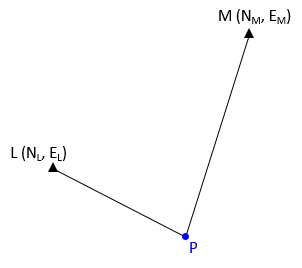Chapter B. Intersections
1. Solving point positions
a. Connecting an unknown position
A point whose absolute position is to be determined has two unknowns: North and East. To solve both unknowns requires two measurements connecting the point to a set of known coordinates. In the case of a point-to-point forward computation, the unknown point is connected with a length and direction to a single known point, Equations A-1 and A-2.
The two measurements don't have to be from a single point. In Figure B-1, the coordinates of points L and M are known, point P's are not.
|
|
|
Figure B-8 |
The forward computation Equations A-1 and A-2 can be written for point P from points L and M:
| Equation B-1 | |
| Equation B-2 |
Equations B-2 and B-8 have four unknowns: LLP, DirLP, LMP, and DirMP.
b. Intersections
To solve the position of point P, it must be connected to points L and M using one of the following combinations:
- LLP and DirMP
- DirLP and LMP
- LLP and LMP
- DirLP and DirMP
These are the standard COGO intersections since point P is at the intersection of two measurements. There are three intersections based on the type of measurements:
- Distance-direction (or Direction-distance, we'll use these interchangeably)
- Distance-distance
- Direction-direction
Fixing two of the measurements allows solution of the other two. For example, given the coordinates of points L and M, and the azimuths from both to point P:
| Point | North (ft) | (East) | Azimuth to P |
| L | 614.80 | 2255.90 | 117°22'40" |
| M | 791.53 | 2517.03 | 198°10'30" |
Equations B-1 and B-2 can be written as:
| Equation B-3 | |
| Equation B-4 |
These can be solved simultaneously for LLP and LMP. Either distance can then be substituted back into its respective side of Equations B-3 and B-4 to perform a forward computation to point P.
The problem is that while a direction-direction intersection is relatively easy to solve simultaneously, the other two types are not. The two equations for a direction-distance intersection will contain the sine and cosine of one unknown direction; distance-distance intersection equations will contain the sine and cosine of two unknown directions. Because sine and cosine functions are non-linear, these are not trivial solutions.
So how do we go about solving direction-distance and distance-distance intersections?
d. Solution Methods
For manual solutions, there are two general ways to solve COGO intersections:
- Triangle-based
- Arc-based
For both, we'll look first at its underlying geometry then how it's applied for the different types of intersections.
